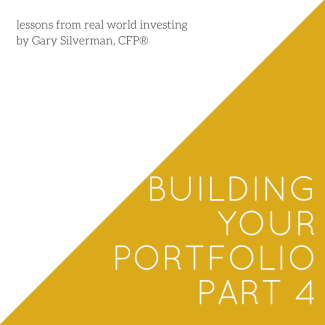
Portfolio Building: Logic over Emotion
By Gary Silverman, CFP®
Last week we looked at the two main ways to invest your money: buy-and-hold and rebalancing.
Buy-and-hold is easy—you buy an investment and you keep it until you need to turn it into cash to spend.
Rebalancing rebalances things. Whatever asset allocation you figured out was best for you when you started things is your target. When market movements throw your portfolio off your targets you sell what has grown too big and buy what shrank a bit. This sounds well and good until you go to do it. In an extreme example, consider November of 2008.
Imagine it’s late 2008. You would have looked at your portfolio and seen that stocks lost about half their value from the same time the previous year. How likely are you to sell off some of your nice, safe bonds and buy some of those evil risky stocks?
If you’re normal your natural tendency is to want to get rid of what has been doing badly and buy more of what has been making you money. So it is not likely at all that the normal person will want to rebalance in the right direction. Fortunately for my clients, I’m not normal. (I heard those snickers.)
I remember a phone call I had gotten from a client one afternoon. Seems he had been looking over his investment account statements for the last year or two. He remarked, “I see that we’ve done exceptionally well in fund X.”
“Yes,” I said, “we’ve made a lot of money for you in that fund.”
“Indeed,” he went on, “but I’m concerned because it seems like fund Y hasn’t gone anywhere in the last year…don’t you think we should do something about that?”
“Absolutely, and it is remarkable that you called today, as we just changed those two positions around,” I relayed to him. “Oh great!” he exclaimed. To which I replied, “Yes, we sold off some of fund X and used the money to buy more of fund Y.”
There was silence on the other end of the line. That silence told me that he understood what I was saying: I had sold off a good chunk of the fund he was loving and purchased more of the fund that was causing him worries due to its recent underperformance. I finally broke the silence. “My idea of how to make money is to buy low and sell high. Do you think this is a good strategy?”
We then spent a bit of time reviewing how rebalancing works in helping his portfolio not to get too heavy in any one investment or investment type.
There are many variations to this theme, each promising to fix the problems in either strategy. But I’ve outlined the main differences and problems that I’ve noted most people have with them. With either, you can be successful. Just don’t think either one is problem-free. Now that you realize that, next week we can look at the specifics of how I create portfolios for my clients.
Gary Silverman, CFP® is the founder of Personal Money Planning, LLC, a Wichita Falls retirement planning and investment management firm and author of Real World Investing.

